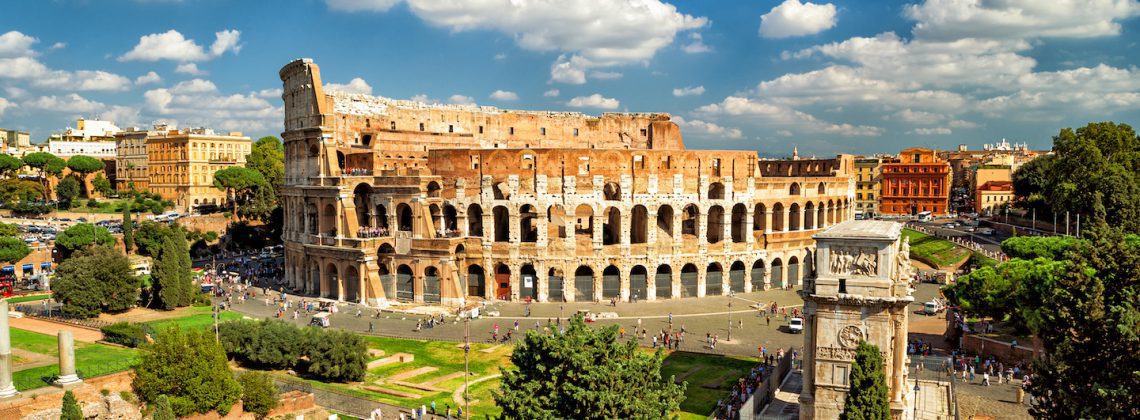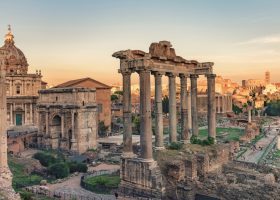When you think about the Colosseum, gladiators likely come to mind. Indeed, while gladiatorial contests are a huge part of the Colosseum’s story, there are many layers to this arena’s nearly 2,000-year history. Check out this brief history of the Colosseum written by a historian!
This article isn’t meant to replace a guided visit – quite the opposite! Reading up on an attraction will make a guided tour more memorable and interesting! You will impress your travel partners and engage more with the guide. Check out our guided tours of the Colosseum!
A Look at Nearly 2,000 Years of History at the Colosseum
Some people say a certain arena in New York City is the world’s most famous. But those people forget about Rome’s legendary Colosseum. One of the few must-have attractions on any bucket list, the Colosseum has been leaving visitors to Rome awestruck for almost 2,000 years!
However, for as iconic as the Colosseum is to the landscape of Rome, there is surprisingly little comprehensive scholarship on the venue’s long history. For instance, art historian Alta Macadam explains that most studies focus on the Colosseum’s architectural features rather than its history.
But fear not! This brief article gives you a crash course on one of Rome’s (and indeed the world’s) most storied and visited landmarks.
Why is The Colosseum So Important?
The Rose Bowl in Pasadena hosts the game popularly called the “Grandaddy of them all.” But that would make the games held in the Colosseum the great-great- (many more greats)-grandaddy of all competitions. Indeed, in many ways, the Colosseum is the forerunner of the mega stadiums of our world.
But the Colosseum is so much more than an ancient arena. In fact, there is arguably no better remaining monument to the architectural and engineering marvels of the Roman Empire. However, there is also the initial function as a venue for staging events like gladiatorial contests. According to art historian Nathan T. Elkins, such events give the Colosseum its legacy as a “monument to dynasty and death.”
Like other famous monuments worldwide like the Parthenon in Athens, many different regimes made their mark on the Colosseum. Indeed, as we’ll see below, the Colosseum has worn many hats over the centuries-arena, fortress, church, quarry, green space, and finally iconic monument. So, let’s start at the beginning.
69 AD -79 AD
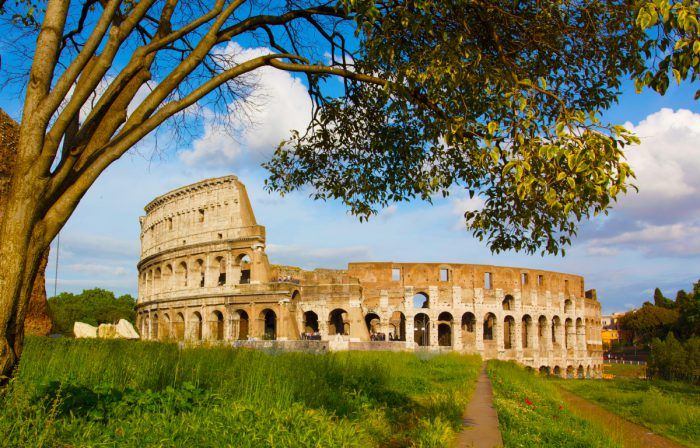
Chaotic Origins | Construction | Flavian Dynasty
Our story begins at what you might think is an odd time to build a giant stadium. In fact, the Colosseum’s history opens with the Roman Empire in chaos. The Julio-Claudian dynasty, which ruled Rome since Augustus became the first emperor in 27 BC, was on the verge of collapse by 68-69 AD.
But the resolution to that chaos encouraged a spectacular display of Roman might and ingenuity in hopes of fostering stability. As art historian Nathan Elkins says, that project came to be embodied by the arena we know as the Colosseum. Elkins says that while ostensibly built to please the Roman people after turbulent times, the Colosseum (originally Flavian Amphitheater) was really all about the Flavian dynasty.
As a monument to Flavian power, historian Christopher Kelly tells us construction began in the early 70s AD under Emperor Vespasian. It involved draining part of Emperor Nero’s Lake, another sign of Roman ingenuity in their mastery of the city’s urban and natural environment.
Archaeologist Letizia Abbondanza says the arena ultimately measured approximately 189 x 156 meters (620 x 513 feet). The structure rapidly took shape with building materials, including travertine marble, tufa, and concrete. Moreover, the oval-shaped arena’s façade incorporates 3 orders of Greek columns: Doric (ground level), Ionic (second story), and Corinthian above.
80 AD
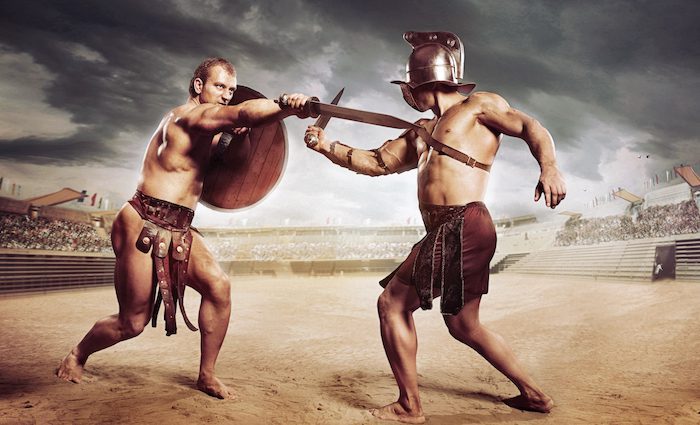
Inaugural Games | Emperor Titus | 100 Days of Events
Vespasian, however, as scholar Nathan Elkins tells us, did not live to see the structure fully completed. In fact, historians say that only became a reality by AD 82 under Domitian. However, it was Vespasian’s successor and son Titus who had the honors of inaugurating the Colosseum. And you could say that there was a little fanfare involved in the Colosseum’s inaugural games in 80 AD.
In fact, the Colosseum did not have an opening day. Instead, Titus began a 100-day marathon of events to celebrate the grand arena and the Roman Empire. And a great arena it certainly was. For instance, the Colosseum had no less than 80 entrances! Thus, the Colosseum, believed by scholars to seat at least 50,000 people thus played host to various competitions and curiosities in that 100-day inaugural celebration.
Spectacles held at the Colosseum also gave audiences visual evidence of the Roman Empire’s staggering economic and military might. As archaeologist Letizia Abbondanza explains, a seemingly endless parade of exotic animals entered the Colosseum. For example, the Roman poet Martial described audiences enthralled by the sight of animals from as distant as present-day Iran and Scotland.
Planning a Trip to Rome? Check out our article on the best hotels in Rome!
80 AD-c.100 AD
Fan Experience | Souvenirs | T-Shirt Toss?
So, what was it like to go to the Colosseum in Imperial Rome? Scholars have uncovered a great deal of the average spectator’s possible typical experience there in Roman times. For example, we know audiences enjoyed cover from the sun thanks to a giant awning called a velarium. According to art historian Nathan Elkins, hundreds of sailors operated the velarium during events.
Gladiatorial combat is the most famous of the events associated with the Colosseum. Moreover, archaeologist Kimberly Cassibry tells us that the best gladiators emerged as the Roman equivalents of modern sports stars. Cassibry says they even had their likenesses on commemorative cups and other objects.
Furthermore, events at the Colosseum also reveal the origins of many activities at sporting events we attend today. Historian Christopher Kelly shares my favorite connection between the Colosseum and activities at our sporting venues, namely the t-shirt toss. Yes, you’ve read that correctly. While not exactly t-shirts, Kelly says Roman emperors would occasionally throw wooden balls into the crowd redeemable for items like food, clothing, or even horses!about:blankEmbed URLPaste a link to the content you want to display on your site.EmbedLearn more about embeds(opens in a new tab)Sorry, this content could not be embedded.Try again Convert to link
c.100-176 AD
Munera & Venationes | Mythmaking | Variety
Despite the fame of gladiatorial combat, known as munera, the Colosseum hosted a variety of spectacles. Events beyond gladiatorial fights ranged from mock hunts of ferocious animals (venationes), public executions, and funerary games to honor deceased emperors.
We’re all familiar with scenes of gladiators duking out from Hollywood and romanticized paintings from later times. However, gladiatorial combat and other elements of the Colosseum’s experience in Roman times did not often look like it does in the movies. At the same time, many mysteries remain.
For example, historian John Fort says scholars are divided about gladiatorial combat’s origins. Archaeologist Letizia Abbondanza says for instance some scholars cite Etruscan influence in creating Roman gladiatorial competition. Furthermore, Abbondanza continues, even ancient Roman authors like Livy bickered over its origins.
The Colosseum, as archaeologist Letizia Abbondanza tells us, also hosted mock naval battles called naumachiae.While this type of event might sound spectacular (and many staged at various times were), naumachiae held in arenas like the Colosseum lost much public enthusiasm after initial interest.
176 AD-217 AD
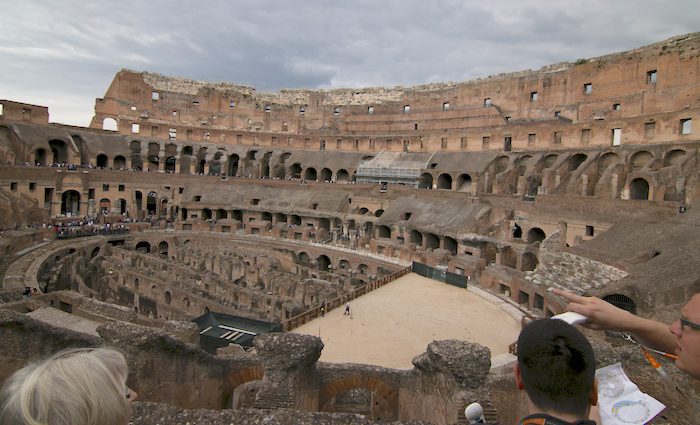
Commodus| Seating Arrangements | Popularity Poll
Moreover, not all those who entered the arena to fight in gladiatorial combat or mock hunts were slaves, condemned men or women, or otherwise socially marginalized. In fact, as Nathan Elkins reminds us, gladiators did not die at rates portrayed in modern media, and sometimes wealthy influential Romans tested their skills. Roman statesman and historian Cassius Dio relates stories of co-emperor Commodus (r.176-192) hunting over a hundred bears behind the security of a specially engineered gallery.
Spectators also didn’t need to access an ancient version of Stubhub to get premium access to games and spectacles held at the Colosseum. In fact, historian Christopher Kelly tells us that a wooden tessera (ticket) sufficed for people to enter. You can be sure that a ticket to the Colosseum was as sought after as any of today’s major sporting events.
Rather than cost, though, class hierarchies in Imperial Rome dictated where people sat in the Colosseum. Christopher Kelly explains that the well-to-do had roughly 60% of seating. On the other hand, the urban poor received about 20% of seats in the rear. Other areas were reserved for notables, functionaries, and of course, the emperor’s entourage.
Scholar Nathan Elkins says you could gauge an emperor’s popularity by the spectacles they hosted at the Colosseum. Generally, popular emperors enjoyed the Colosseum’s atmosphere. On the other hand, Elkins continues, some joked when Tiberius died that his body should be burned in the Colosseum so that at last, he would have provided some entertainment. Nevertheless, most emperors in the Colosseum’s heyday understood the importance of hosting big events.
217AD-523 AD
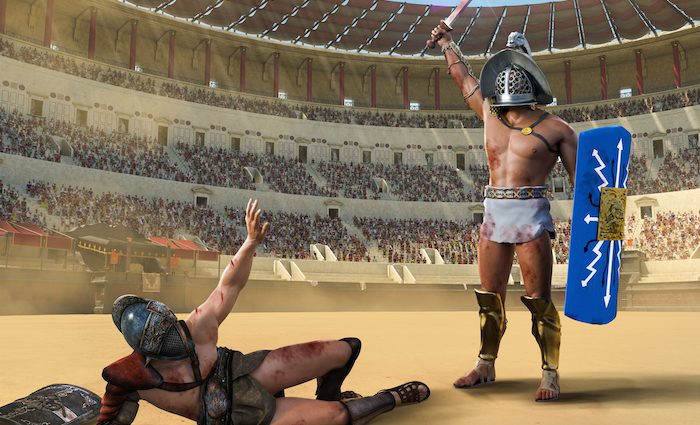
Last Hurrah for Games | Disasters | Quarry
The show could not go on forever, though. Tough times financially, politically, and socially plagued the Roman Empire in later centuries. Furthermore, a series of disasters, including fires, earthquakes, and lightning strikes, damaged the Colosseum.
However, some Roman rulers did, in fact, restore the Colosseum in the wake of such devastation. For example, art historian Nathan Elkins explains that Alexander Severus restored the Colosseum after a fire in AD 217.
A series of earthquakes in the fifth century, including that of 443 AD, damaged the Colosseum. By that point, interest in hosting such games also faded. In fact, as archaeologist Letizia Abbondanza explains, Christian emperors generally opposed such spectacles. As a result, Abbondanza continues, Honorius suspended gladiatorial games, and Valentinian abolished them in AD 438. Furthermore, the last hunts were organized the following century in 523.
Far from remaining a popular arena, the Colosseum instead became an object to be plundered. In fact, for roughly 1,000 years before preservation efforts in the 18th and 19th centuries, the Colosseum was reduced to a quarry. Thus, the Colosseum’s impressive materials served as pre-cut stone for anyone willing and able to haul them away. As a result, as scholar Carol King explains, materials from the Colosseum were reused in other landmarks, including St. Peter’s.
523-1776
Other Functions | Decay | Grand Tour Revival
However, the Colosseum’s later story is not all about plunder. In fact, the Colosseum served several other functions before serious preservation efforts occurred. For example, as scholar John Fort points out, the Colosseum later became part of the Frangipane family’s fortress.
Moreover, as archaeologist Letizia Abbondanza notes, the Colosseum housed a chapel. Furthermore, some ancient practices continued at the Colosseum in the early Middle Ages. Namely, this involved some papal-sanctioned public executions. For example, art historian Nathan Elkins relates evidence of public executions of condemned criminals during the Papacy of Pope Stephen III (768-772).
As Letizia Abbondanza explains, by the 11th century, we see mention of the arena as the “Colosseum,” a nickname likely derived from a colossal statue of Nero that once stood nearby. Despite the grandiose nickname and influential protectors in the Papacy and families like the Annibaldi and Frangipane, the Colosseum continued to decay. Furthermore, mother nature once again wreaked havoc on the Colosseum. A devastating earthquake in 1349 resulted in the collapse of the entire south side.
However, the Colosseum by the 17th and 18th centuries got more attention with the growth of visitors from northern Europe. According to historian Eric G.E. Zuelow, many young studious arrivals to Rome passed through the city on what became known as the Grand Tour. Yet even this renewed fascination with Rome and its landmarks like the Colosseum did not immediately yield funding and momentum for restoration.about:blankEmbed URLPaste a link to the content you want to display on your site.EmbedLearn more about embeds(opens in a new tab)Sorry, this content could not be embedded.Try again Convert to link
1776-Present
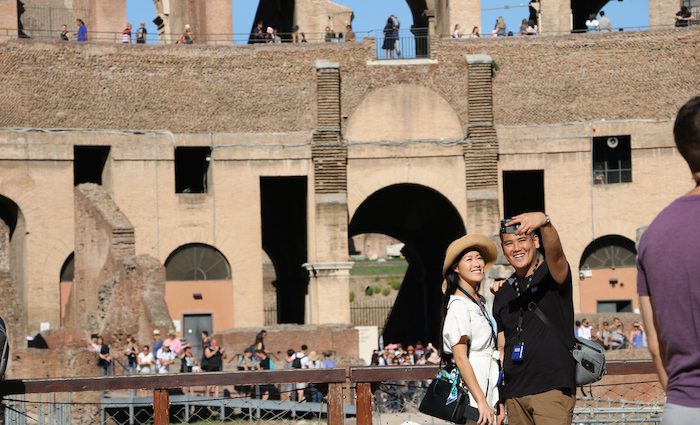
Preservation | Vegetation | Modern Tourist Attraction
Indeed, after being the pride and joy of Roman emperors, the Colosseum saw less glamorous days. For example, historian R.J.B. Bosworth says the Colosseum’s outer arches were a storage place for manure until 1811.
Yet, by that point, calls for the Colosseum’s preservation grew from various quarters. In fact, historian R.J.B. Bosworth says a lightning strike in July 1776 brought particular attention to the structure’s plight. By the 1780s, annual reports on necessary excavation and restoration work in Rome were published under Papal authorities.
Nevertheless, the Colosseum remained a far cry from its heyday as a major arena and symbol of Imperial Rome. However, one feature of its decline strongly appealed to 19th century visitors. Namely, the vast green vegetation that grew within the crumbling and pillaged walls. According to scholar John Fort, Roman-born British author Augustus Hare resented efforts to remove the Colosseum’s vegetation.
Yet, in 1873 there was still enough vegetation growing in the Colosseum. In fact, that year, British naturalist Richard Deakin published a book titled “Flora of the Coliseum.” Deakin’s book listed hundreds of species, including fig and olive trees. Nevertheless, officials cleared out this growth throughout the 1880s and 1890s as part of an ambitious renovation of Rome as the Italian capital city.
Over the 20th century, the Colosseum survived urban renewal projects and the devastation of war and occupation during WWII. The 1990s witnessed the most recent surge in preservation projects involving the Colosseum. As restoration and excavations continue, the Colosseum remains one of Europe’s most visited tourist attractions.

